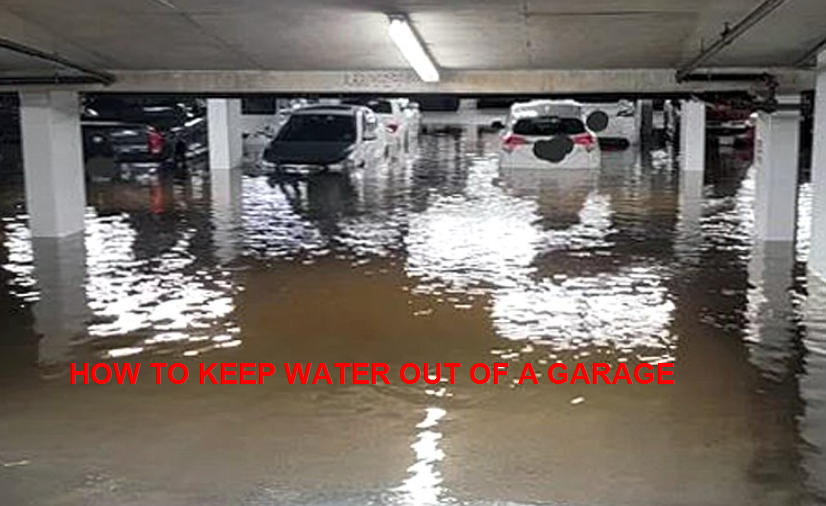Do you know how to keep water out of a garage? Keeping water out of your garage is paramount for maintaining its structural integrity and safeguarding any valuable items stored inside. In this guide, we’ll explore various strategies on how to keep water out of a garage and protect it from potential damage.

Inspect and Repair Cracks
Inspecting and repairing cracks in your garage is a crucial step in keeping water out and maintaining the integrity of the structure. Cracks in the floor, walls, or foundation can provide pathways for water infiltration, leading to potential damage and deterioration over time. Here’s why inspecting and repairing cracks is essential:
- Preventing Water Seepage: Cracks in the garage floor or walls can allow water to seep in, especially during heavy rainfall or melting snow. This water intrusion can lead to dampness, mold growth, and damage to stored items.
- Preserving Structural Integrity: Over time, water entering through cracks can cause the concrete or masonry to weaken and deteriorate. This compromises the structural integrity of the garage, potentially leading to more extensive and costly repairs down the line.
- Avoiding Foundation Issues: Cracks in the foundation pose a particular risk, as they can allow water to penetrate deep into the structure, leading to foundation settlement, shifting, or even structural failure. Repairing these cracks promptly helps prevent serious foundation issues.
- Preventing Further Damage: Ignoring cracks in the garage only allows the problem to worsen over time. By addressing them early on, you can prevent further damage and avoid more extensive repairs in the future.
To inspect and repair cracks in your garage effectively, follow these steps:
- Visual Inspection: Regularly inspect the garage floor, walls, and foundation for any signs of cracks. Look for hairline cracks, larger fissures, or areas where water stains may indicate previous water intrusion.
- Cleaning the Area: Before repairing the cracks, clean the affected area thoroughly to remove any debris, dirt, or loose material. Use a wire brush, vacuum, or pressure washer to ensure a clean surface for better adhesion of repair materials.
- Choosing the Right Repair Method: Select an appropriate repair method based on the size and severity of the cracks. For small hairline cracks, a simple concrete crack sealer may suffice, while larger or structural cracks may require epoxy injection or professional assistance.
- Applying Sealant or Patching Compound: Fill the cracks with an appropriate sealant or patching compound, following the manufacturer’s instructions. Ensure the material fills the crack and forms a watertight seal to prevent future water infiltration.
- Allowing Proper Drying and Curing: Allow the sealant or patching compound to dry and cure completely before resuming normal garage use. This may take several hours or days, depending on the product used and environmental conditions.
- Monitoring for Future Cracks: Continue to monitor the garage for any new cracks or signs of water intrusion, especially after heavy rainfall or changes in weather conditions. Address any new cracks promptly to prevent further damage.
How To Keep Water Out Of A Garage (Checking The External Conditions)
While inspecting and repairing cracks within the garage structure is crucial, it’s equally important to address external factors that can contribute to water infiltration. Here’s how external factors play a role in keeping water out of a garage:
1. Gutters and Downspouts: Properly functioning gutters and downspouts are essential for directing rainwater away from the garage’s foundation. If gutters are clogged or downspouts are not directing water far enough from the structure, it can lead to water pooling near the garage and potentially infiltrating through cracks or weak points.
2. Landscaping: The landscaping around the garage can impact water flow and drainage. Plants or shrubs positioned too close to the structure may obstruct proper water runoff or retain moisture, increasing the risk of water intrusion. Maintaining a clear area around the garage can help prevent these issues.
3. Sealant and Waterproofing: Applying sealant or waterproofing products to the exterior surfaces of the garage, such as walls and foundation, creates an additional barrier against water penetration. These protective coatings help repel water and prevent it from seeping into the structure, complementing the repairs made to cracks and gaps.
4. Drainage Systems: Installing additional drainage systems, such as French drains or channel drains, around the perimeter of the garage can help divert water away from the structure. These systems collect and channel water to designated areas, reducing the risk of water pooling near the garage and infiltrating through vulnerable areas.
5. Regular Maintenance: Regularly inspecting and maintaining the external components of the garage, such as gutters, downspouts, and drainage systems, is essential for ensuring they function properly. Clearing debris from gutters, checking for clogs in downspouts, and repairing any damage promptly can help prevent water-related issues.
By addressing both internal structural concerns and external factors that contribute to water infiltration, you can effectively keep water out of your garage and protect it from potential damage.
How To Keep Water Out Of A Garage (Addressing Structural Concerns)
Focusing on structural factors such as inspecting and repairing cracks is crucial for preventing water infiltration into a garage. Structural integrity forms the foundation of any effective water management strategy. Here’s why addressing structural concerns is one way that you should know when you learn how to keep water out of a garage:
- Foundation Stability: Cracks in the garage floor or walls often originate from underlying issues with the foundation. Repairing these cracks not only prevents water from seeping in but also helps maintain the stability and strength of the foundation. A stable foundation is essential for supporting the entire structure and preventing water-related damage.
- Preventing Structural Deterioration: Water infiltration through cracks can lead to structural deterioration over time. Moisture ingress can weaken concrete, corrode metal reinforcements, and compromise the overall integrity of the garage’s structure. By repairing cracks promptly, you can mitigate the risk of long-term structural damage caused by water exposure.
- Mold and Mildew Prevention: Cracks in the garage provide ideal environments for mold and mildew growth, as they offer moisture and organic materials for these organisms to thrive. Repairing cracks helps eliminate entry points for water, reducing the likelihood of mold and mildew infestation within the structure. This is essential not only for protecting the garage but also for maintaining indoor air quality and preventing health hazards.
- Preserving Interior Finishes: Water infiltration through cracks can damage interior finishes such as flooring, drywall, and paint. Repairing cracks helps prevent water from reaching these surfaces, preserving their appearance and functionality. This is particularly important if the garage serves as a living space, workshop, or storage area for valuable items susceptible to water damage.
- Enhancing Energy Efficiency: Gaps and cracks in the garage allow conditioned air to escape and outdoor air to enter, compromising energy efficiency. Sealing these openings can improve insulation and reduce energy consumption associated with heating and cooling the garage space. This not only saves on utility bills but also enhances comfort and livability.
In summary, while external factors that we check when learning how to keep water out of a garage, addressing structural concerns such as inspecting and repairing cracks forms the foundation of an effective water management strategy. By prioritizing above above factors, you can safeguard the garage against water infiltration, structural deterioration, and associated damages, ensuring its longevity and functionality for years.


